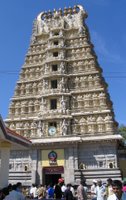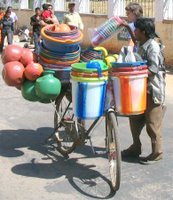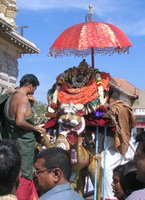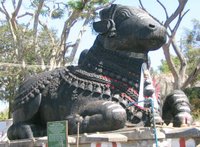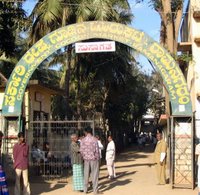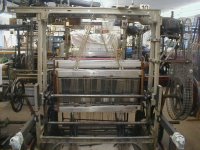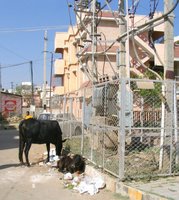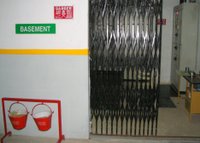Kerala Boat Ride and the New Dirt Road
Our five day t
 rip to the southern most state in India included a day-long boat ride. We boarded our fabulous vessel with Rich and Marion Arnold about 1:30 one afternoon and were handed young coconuts that had had the tops cut off and a straw inserted. Coconut milk is a sweet, refreshing drink. The plan was to cruise through the canals, christened the “Venice of India.” The captain backed the boat away from the dock, threw the engine into forward, and…we drifted. The mount that held the motor to the boat had broken! An anchor was thrown overboard, calls were made, and within 45 minutes a small motor boat was pulling our large boat with a rope.
rip to the southern most state in India included a day-long boat ride. We boarded our fabulous vessel with Rich and Marion Arnold about 1:30 one afternoon and were handed young coconuts that had had the tops cut off and a straw inserted. Coconut milk is a sweet, refreshing drink. The plan was to cruise through the canals, christened the “Venice of India.” The captain backed the boat away from the dock, threw the engine into forward, and…we drifted. The mount that held the motor to the boat had broken! An anchor was thrown overboard, calls were made, and within 45 minutes a small motor boat was pulling our large boat with a rope.
For five hours we plied the quiet waters of Kerala, and just enjoyed the pleasant breeze, the shade of the canopy on our craft, dozing, reading and the scenery. Among the many things we saw in or at the
 edge of the river were people bathing, women washing clothes, men loading flatboats beyond capacity, children going to school
edge of the river were people bathing, women washing clothes, men loading flatboats beyond capacity, children going to school  via boat, and many other of the daily activities of the local people.
via boat, and many other of the daily activities of the local people.At 6:30 we moored and were told that we needed to get off the water “for the fishermen.” We knew better. Within minutes there were several men in a small boat who had pulled along side our boat to see what could be done about the motor mount. We were escorted off the boat and told it would be pleasant to stretch our legs and take a little walk.
 It just so happened that, just prior to our arrival, a new dirt road had been completed and the local officials were having a dedication ceremony. The celebration was about 50 feet from where we had docked. There was a sound system loud enough to be heard almost to Bangalore, and we listened to children singing,(audio) citizens giving thanks and politicians giving speeches for about 2 ½ hours. After just a few minutes of this at close range, we
It just so happened that, just prior to our arrival, a new dirt road had been completed and the local officials were having a dedication ceremony. The celebration was about 50 feet from where we had docked. There was a sound system loud enough to be heard almost to Bangalore, and we listened to children singing,(audio) citizens giving thanks and politicians giving speeches for about 2 ½ hours. After just a few minutes of this at close range, we  decided to take a walk along the new dirt road and discovered that it had been cut through someone’s rice field, but it ended at a main road that lead into a small town. It was a nice dirt road, but we wondered how well it would survive the first monsoon rains.
decided to take a walk along the new dirt road and discovered that it had been cut through someone’s rice field, but it ended at a main road that lead into a small town. It was a nice dirt road, but we wondered how well it would survive the first monsoon rains. When we got back to the boat at dusk, the speech-giving was just about at its conclusion. We were glad we would be able to eat in peace and quiet. In the quiet before our next aural treat, we listened as a boat full of singing men (audio)slowly worked its way across the waterway. Shortly after this peaceful song, we were treated to three hours of a man and a woman on the other side of the waterway alternately singing songs on another excessively loud speaker system.
When we got back to the boat at dusk, the speech-giving was just about at its conclusion. We were glad we would be able to eat in peace and quiet. In the quiet before our next aural treat, we listened as a boat full of singing men (audio)slowly worked its way across the waterway. Shortly after this peaceful song, we were treated to three hours of a man and a woman on the other side of the waterway alternately singing songs on another excessively loud speaker system.We did, however, have a tasty meal prepared for us. Nothing was so spicy that we couldn’t eat it. The bedrooms were equipped with AC so we slept well.
At 7:00 the next morning we disembarked the first boat and boarded a second boat whi
 ch took us through the canals for another four hours. One sight that took us by surprise was the sight of another tour boat like ours with the cook crouched at the side of the boat, washing the dishes in the river. Marion and I looked at each other with wide eyes and mouth open, but we didn’t say anything. We knew.
ch took us through the canals for another four hours. One sight that took us by surprise was the sight of another tour boat like ours with the cook crouched at the side of the boat, washing the dishes in the river. Marion and I looked at each other with wide eyes and mouth open, but we didn’t say anything. We knew.
